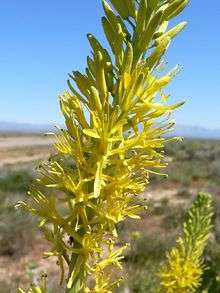Stanleya pinnata
| Stanleya pinnata | |
|---|---|
 | |
| Scientific classification | |
| Kingdom: | Plantae |
| (unranked): | Angiosperms |
| (unranked): | Eudicots |
| (unranked): | Rosids |
| Order: | Brassicales |
| Family: | Brassicaceae |
| Genus: | Stanleya |
| Species: | S. pinnata |
| Binomial name | |
| Stanleya pinnata (Pursh) Britton | |
Stanleya pinnata is a species of flowering plant in the mustard family known by the common name desert princesplume.[1]
Distribution
The plant is native to the western Great Plains and the Western United States. [2]
It occurs in many types of open habitat, including deserts, chaparral, foothills, rocky cliffs, sagebrush, and prairie. It prefers alkali- and gypsum-rich soils.[3]
Description
Stanleya pinnata is a perennial herb or shrub producing several erect stems reaching up to about 1.5 metres (4.9 ft) in maximum height. The stems are hairless, often waxy in texture, and have woody bases. The leaves have fleshy blades up to 15 centimeters long by 5 wide which are divided into several long, narrow lobes. The blades are borne on petioles.
The top of the stem is occupied by a long inflorescence which is a dense raceme of many flowers. Each flower has narrow yellowish sepals which open to reveal four bright yellow petals each up to 2 centimeters long. The stamens protruding from the flower's center may approach 3 centimeters in length.
The fruit is a curving, wormlike silique up to 8 centimeters long.
Uses
It was used as a Native American traditional medicinal plant and food source, including by the Hopi, Zuni, Paiute, Navajo, Kawaiisu, and Tewa peoples. [4]
References
- ↑ "Stanleya pinnata". Natural Resources Conservation Service PLANTS Database. USDA. Retrieved 1 December 2015.
- ↑ Flora of North America
- ↑ Houk, Rose. (1987). Wildflowers of the American West . Chronicle Books, San Francisco. ISBN 0-87701-424-8.
- ↑ University of Michigan at Dearborn: Native American Ethnobotany of Stanleya pinnata
External links
- Calflora Database: Stanleya pinnata (Desert princesplume, Prince's plume)
- USDA Plants Profile for Stanleya pinnata (desert princesplume)
- Jepson Manual eFlora (TJM2) treatment of Stanleya pinnata var. pinnata
- UC CalPhotos gallery
| Wikimedia Commons has media related to Stanleya pinnata. |